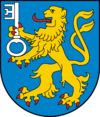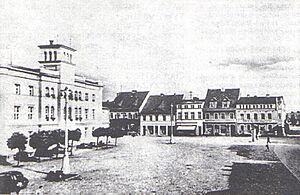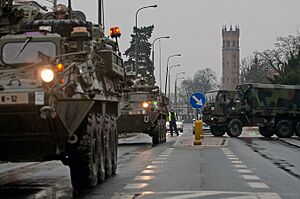Skwierzyna facts for kids
Quick facts for kids
Skwierzyna
|
|||
|---|---|---|---|

Market Square with the town hall in the foreground and the Saint Nicholas church in the background
|
|||
|
|||
| Country | |||
| Voivodeship | Lubusz | ||
| County | Międzyrzecz | ||
| Gmina | Skwierzyna | ||
| Town rights | before 1296 | ||
| Area | |||
| • Total | 35.89 km2 (13.86 sq mi) | ||
| Population
(2023-12-31)
|
|||
| • Total | 9,078 | ||
| • Density | 252.94/km2 (655.11/sq mi) | ||
| Time zone | UTC+1 (CET) | ||
| • Summer (DST) | UTC+2 (CEST) | ||
| Postal code |
66-440
|
||
| Car plates | FMI | ||
| Website | http://www.skwierzyna.pl | ||
Skwierzyna is a town in western Poland, located in the Lubusz Voivodeship. It's the main town of the Gmina Skwierzyna area. As of late 2023, about 9,078 people live there.
Skwierzyna is special because it sits where two rivers meet: the Obra and the Warta. It's about 18 km (11 mi) north of Międzyrzecz and 23 km (14 mi) south-east of Gorzów Wielkopolski, a bigger city. The town is known for its beautiful green surroundings, with lots of forests and lakes nearby.
Contents
A Look Back in Time: Skwierzyna's History
Skwierzyna started as a small fishing village, built by Slavs a long time ago. It was on an important trade route that connected Szczecin and Kraków.
Early Polish History
In the 10th century, Skwierzyna became part of the new Polish state. Over the years, it was part of different Polish regions. It gained "town privileges" (special rights for towns) before 1296. King Władysław II Jagiełło renewed these rights in 1406.
The people living in Skwierzyna were mostly Polish, Jewish, and German. Monks from a nearby monastery helped settle the area. In 1530, Skwierzyna got its own coat of arms. By 1543, it was an official "royal town" of the Polish Crown.
Changes and Challenges
In 1793, Skwierzyna became part of the Kingdom of Prussia, a German state. But for a short time, from 1807 to 1815, it was part of the Polish Duchy of Warsaw. After that, it went back to Prussia.
In 1871, it became part of the new German Empire. Many Polish people in Skwierzyna wanted the town to be part of an independent Poland again. They even took part in the Greater Poland uprising after World War I. However, because most people in the town spoke German, it stayed in Germany.
In 1938, Skwierzyna became part of the Province of Brandenburg. During World War II, a camp for Poles was in the town in 1939 and 1940. The town was taken by the Soviet army in January 1945.
Skwierzyna After World War II
After World War II, Skwierzyna became part of Poland again. This was decided by the Potsdam Agreement. The first mayor after the war was Stanisław Runge, a local Pole.
Many Poles who had to leave their homes in eastern Poland (which was taken by the Soviet Union) came to live in Skwierzyna. The first group of about 800 Poles arrived in June 1945. Skwierzyna also became a town with a Polish Army base.
In 1970, a monument to King Władysław II Jagiełło was put up. The town faced floods in 2010 and 2011.
What to See in Skwierzyna
Skwierzyna has several interesting places to visit.
- Town Hall: This historic building is a main landmark.
- Saint Nicholas Church: This church has a beautiful Gothic style. Inside, you can see the Our Lady of Klewań, a special religious painting. This makes Skwierzyna a place where people go on pilgrimages.
- Ulica Marszałka Piłsudskiego: This street is the town's main walking area. It's full of old houses and shops.
- Military Museum Atena: Here you can learn about military history.
- Jewish Cemetery: This is one of the biggest Jewish cemeteries in the Lubusz Voivodeship.
Population Changes
| Historical population | ||||||||||||||||||||||||||||||||||
|---|---|---|---|---|---|---|---|---|---|---|---|---|---|---|---|---|---|---|---|---|---|---|---|---|---|---|---|---|---|---|---|---|---|---|
|
|
|||||||||||||||||||||||||||||||||
Sports in Skwierzyna
The local football team is Pogoń Skwierzyna. They play in the lower football leagues.
Famous People from Skwierzyna
- Johann Christian Metzig (1804–1868), a doctor
- Johann Gottfried Piefke (1817–1884), a musician and composer
- Sebastian Świderski (born 1977), a volleyball player
Sister Cities
To see the towns that Skwierzyna is twinned with, check out the Gmina Skwierzyna page.
Images for kids











